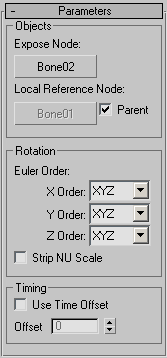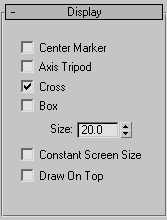The Expose Transform helper exposes values of non-keyed objects for use in expressions and scripts. This lets riggers and animators access a select set of transforms for an object, and between an object and its parent, such as a bone in an IK chain. For example, using the Expose Transform helper, you could write a script or use parameter wiring that tests the angle of an character's arm bone that's controlled by IK (thus, has no keys), and once it exceeds a specific value, rotate the corresponding clavicle bone to deform the shoulder area.
In the viewports, the Expose Transform helper object looks just like a Point helper.
The helper object's position has no bearing on its functionality.
 Parameters rollout, click the Expose Node button (default label: None) and select the object whose transform values you want
to expose.
Parameters rollout, click the Expose Node button (default label: None) and select the object whose transform values you want
to expose.
The object's name appears on the button, and its transform values appear in the fields on the Expose Values rollout.
This option is used by the Local Euler Angles, Distance To Reference, and Angle parameters. If the object has no parent and you don't specify a Local Reference Node object, these fields use the world center (0,0,0) as the reference node.
This copies the transform name, using MAXScript notation, to the copy buffer.
A sample result of this is “$ExposeTransform01.localPositionX”. 3ds Max interprets this as the local position, on the X axis, of the Expose Node object.

These settings let you specify the exposed node, a reference object other than the parent, and rotation and timing parameters.
The object whose relationship with the Expose Node object is used to generate local data for rotation, distance, and angle. Click the button, and then select the object. Available only when Parent is off.
By default, this is the parent object, but you can turn off Parent and then specify a different object.
When on, the Local Reference Node is set automatically to the parent of the Expose Node. When off, you can pick an object to refer to for local data. Default=on.
This is used by the Local Euler Angles, Distance To Reference, and Angle parameters. If the object has no parent and you don't specify a Local Reference Node object, these fields use the world center (0,0,0) as the reference node.
These three settings determine the order in which the Expose Transform helper will look for an Euler rotation.
This parameter corrects for anomalies that can be introduced when a local rotation value is generated in relation to other rotation values. For example, when Z Order is set to XYZ, the Z value is generated in reference to X and then Y. Or when X Order is set to ZXY, the Z value is generated directly in reference to the parent, regardless of X and Y rotations.
When on, lets you specify a frame other than the current one from which to gather data. The Offset value is added to the current frame to derive the frame from which data is gathered.
For example, if the current frame is 20 and you wish to gather data from frame 15, turn on Use Time Offset and set Offset to -5.

Lets you specify how the helper object appears in the viewports. By default, the display type is set to Cross only, and Size is set to 20.0. You can activate multiple display settings if you like.